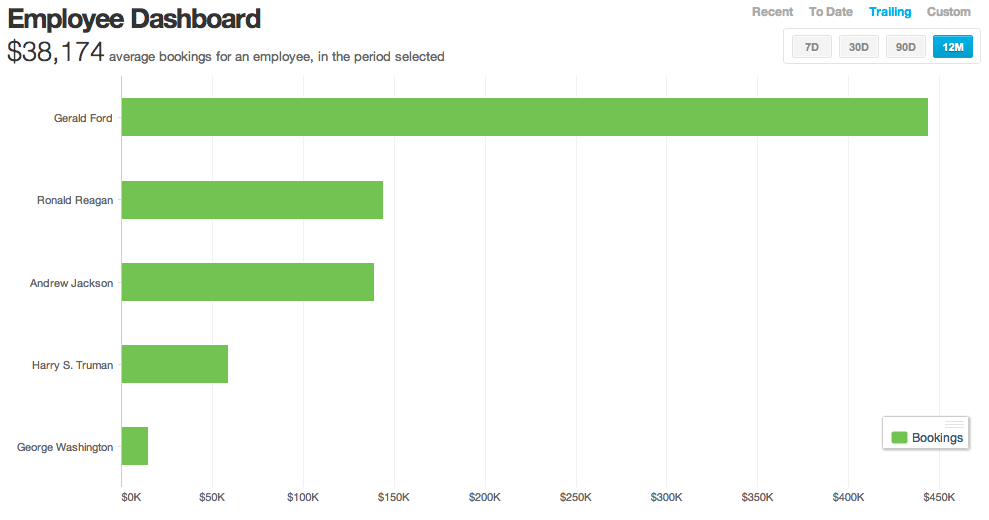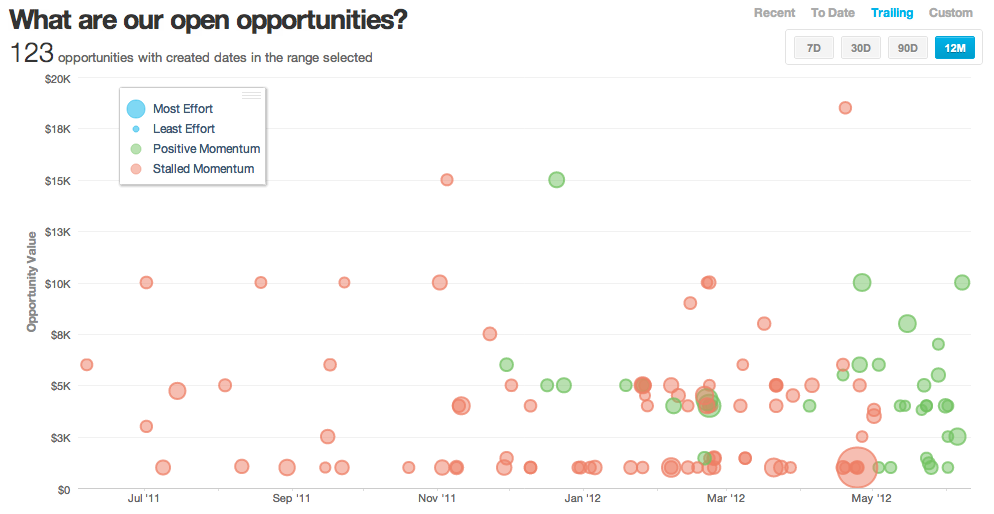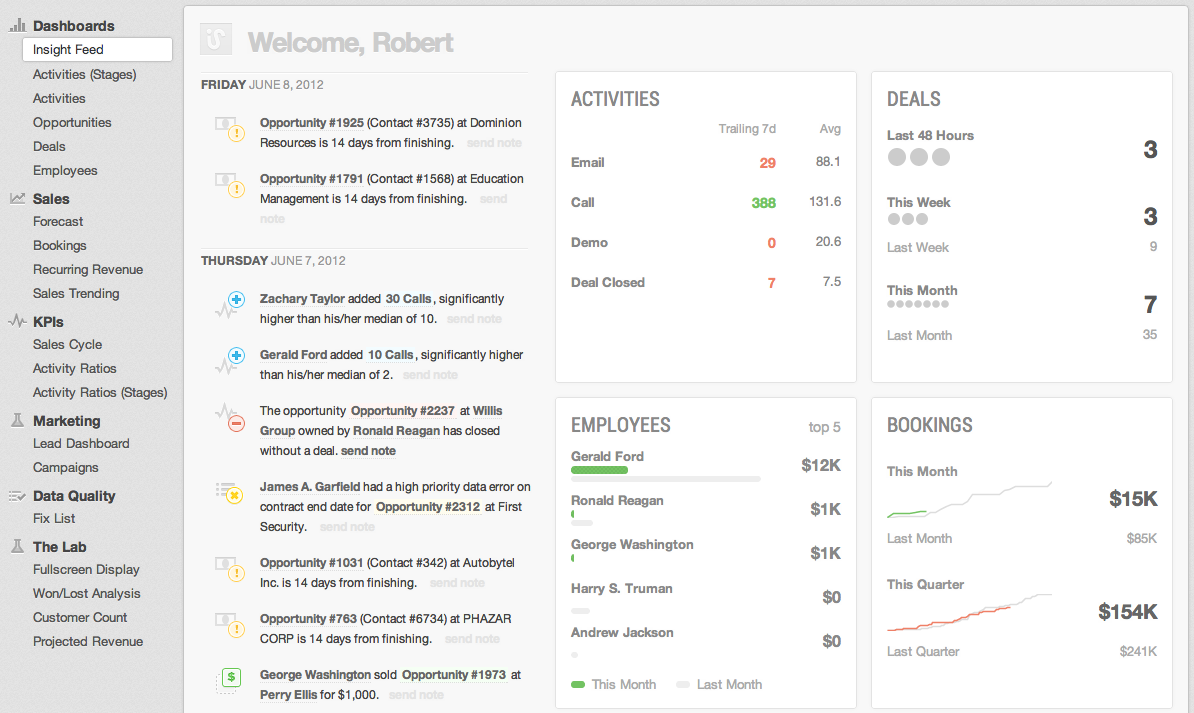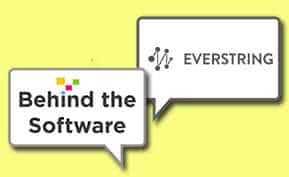Big Data Analytics
InsightSquared Brings Big Data to Small Businesses

Big data solutions for small businesses are almost non-existent in the current market, which is where InsightSquared steps in. Their primary goal is to provide a data intelligence solution to small businesses that’s not only affordable, but can deliver the same amount of value (if not better) that traditional, enterprise-level business intelligence platforms provide. We interviewed InsightSquared CEO and Co-Founder, Fred Shilmover, to talk about InsightSquared’s origin story, the future of BI, and why even small businesses have big data needs.
Can you tell me about how InsightSquared was founded? What was the impetus for doing so?
So when it was just you and your two co-founders [Samuel Clemens and Bryan Stevenson], what was the most difficult part about getting everything started?
I think the biggest challenge in tackling the small business market is customer acquisition and customer retention. In aggregate, the SMB market is a mess. It’s arguably much larger than the enterprise software market, but the challenge is always, “How do you find the customers and how do you retain the customers?” So on the finding the customer side, early on we worked with a number of partners before we had a sales team and a marketing team to find customers for whom reporting and analytics was a pain, making better, more data-driven decisions was something that they were challenged with. So we solved that challenge by working with partners.
On the keeping the customers side, we identified a key failing in business intelligence – at least for the SMB market. It was just too hard to use. It was too complex and too expensive. So the problem with BI is it purports to do everything for everybody. Put in any data. We’ll answer any question. It’s a great tool. The problem is for small businesses, they didn’t know the questions they wanted to ask of their data necessarily, and they certainly couldn’t build the analysis in these very, very powerful tools – sometimes very expensive tools.
What do you do to make InsightSquared stand out from all the industry noise?
Our approach was to build a product. Don’t build a platform. Make it feel like a consumer web product. It doesn’t need training, doesn’t need a user manual. And if you keep to that standard – instead of doing that standard BI approach, which is it will answer any question for anybody – we took the other approach. We talked to customers and said, “If you could wave a magic wand and ask your business anything or improve your business in any way, what would you do? How would you do that?” Then they’d ask us a question. In the beginning, we’d say, “It’s a really great question. Give us a couple weeks, and we’ll go build that analysis.”
Overtime as we worked with customers – and we really focused on what kind of customers we worked with – we’d ask that same question: “If you could wave a magic wand and ask your data anything, what would it be?” Then they’d ask us their question, and we’d already have an answer: “Well, this is the answer right here with your data.” As a result, being question-driven and asking, “What’s the fundamental business need?” versus, “Here’s a tool that can do anything,” allows to us build a very different user experience that creates and leads to engagement.

Do you think that that approach is part of why you’re able to deliver the low cost and ease of use that InsightSquared is very clear about as being the driving mission of the company?
Yes. We’re essentially trying to thread a needle by delivering a high value at a price-disruptive cost. The only way to do that is to be laser focused, to be UX/visualization focused, and to really understand how human beings process information. It’s definitely not an Excel spreadsheet. Excel is the most ubiquitous and powerful BI tool on the planet, but it’s not the best way for individuals to interact with information. We focus on threading the needle there, and providing something at disruptively low cost – but also high value.
Along that vein, do you feel it’s mostly complexity that’s the major challenge in business intelligence?
I think complexity comes from that desire to be everything to everybody. I think there are other challenges in business intelligence. For example, there’s cost. Traditionally, business intelligence projects were measured in the millions of dollars. I think some of the newer providers out there have brought those costs down, but haven’t changed the fundamental business model – which is you have to make the investment upfront; it’s still expensive; it still takes months to implement and roll out. Every time you roll out a BI tool, you have to have a consultant come in who understands how to operate it and figure out who the drivers of your business are, what reports you need to build. A lot of times, people still run these reports and export them to Excel. So there are a lot of challenges with BI that we think are fundamental.
We also think that the new BI vendors are lowering the threshold. Instead of it being only a $1 billion business who can afford BI now, it’s a $200 million business or a $100 million revenue business that can afford BI. But there are still relatively few of those businesses. There are lots of $2, $10, $20 million businesses who could be materially improved in terms of their performance if they had a tool that cost $500 or $1,000 a month.
Where do you see the business intelligence industry headed in the next five years? How do you see InsightSquared fitting into that landscape?
Our goal is to disrupt, to fundamentally change the business intelligence landscape by focusing on specific sets of customers that have a lot of similarity. It allows us to do things like benchmarking. We’ve already started working on integrating that into our product. Say I’m a sales rep at particular organization, and I close 38 percent of my business. I can see that the company as a whole maybe closes 45 percent of their business. So maybe I’m below average; but how’s the company doing compared to the industry? And how do we provide really relevant metrics? So benchmarking is a huge part of or our value.
Another thing that we do is multi-data source analysis. The way it works is basically that small businesses, and businesses in general, choose best of breed applications–such as Salesforce.com for their sales team, and QuickBooks for the finance team–and what we’re doing is actually taking those two data sets, or data silos, and bridging them across a business using algorithms to figure out that Acme Co. and Acme Inc., are actually the same company in both systems. Then that allows you to link a DL number in the sales system with DL number in the finance system, for example.
At InsightSquared, we operate with our own tool. Every time a customer of ours logs into InsightSquared and uses the system, we actually log that information to Google Analytics. Then we connect to Google Analytics and bring that information down into InsightSquared. Then we can tell our sales team, “These 50 customers that you have in trial, these are the ones that logged in today. Maybe you should give them a call.” So it provides a really rich tool for the managers and line workers in an organization to use for multiple data sources. So we think that’s groundbreaking. That’s not something that other folks in the BI space are even trying to tackle, or believe it’s possible to tackle.
The last thing I would say that we found incredibly important is this data quality, data compliance. Whenever you have human-generated data, there tends to be quality problems. In the beginning, customers will come to us and say, “You guys have some really powerful analysis – funnel analysis, ratio analysis, forecasting, all this great stuff. But my data is a mess. This is giving me some great ideas and the aspiration to clean up my data. Call me in six months.”
First of all, we didn’t want to wait six months to make a sale. But much more importantly, if it hadn’t happened in the last six months, why is it going to happen in the next six months? So we started to develop a lot of data compliance tools. So let’s say your average sale is $10,000 plus or minus $5,000, and you put in a sale for $10 million. We know you probably just fell asleep on the zero key a couple times. That would totally blow your pipeline report or sales report out of the water. We actually go and find those outliers and replace it with an intelligent guess. What that does is solve the chicken and the egg problem for our customers, where they don’t have to have perfect data to gain insight. We can actually do a lot of intelligent guessing and ease them into an area where they have better data compliance.
What makes you the most excited about InsightSquared and what you guys are doing?
I’d say the data quality part just increases the engagement with the apps that we analyze. I think one of the reasons that Salesforce.com participated in our Series A investment was that we could help – InsightSquared customers are happier Salesforce.com customers, or happier QuickBooks customers. That really makes the partnership very symbiotic.
I think from a technology and value creation perspective, the multi-data source stuff we’re super excited about because it’s one of these one plus one equals three type of things. You can derive a lot of values from analyzing one data source and another data source; but you put the two together, and there’s a lot synergy there. From a technology perspective and innovation perspective, that’s where I think I’m most excited about where we’re headed.

My final question is who do think are the most interesting people or companies in the business intelligence space now? Why do you think that?
I’m super excited about the business intelligence space right now and the analytics space in general. I don’t think InsightSquared is a big data company. We’re an idiosyncratic, messy, small data company, which I think is relatively unique. So when we go into deals, we’re not competitive head to head.
I think in general, the attention to the space, the fact that the instrumentation of the world and big data are becoming so excited. There are tons of companies. There are great companies here in Boston. Bessemer invested in a company called Hadapt. That’s their sister company, helping people make the transition from single technologies to Hadoop.
There’s so much happening there in the space. I think it’s one of these rising tides that raise all ships. We don’t compete head to head for customers, although I think we compete with other companies for mind share in the space. I look forward to there being competitors. I think it would be great for us to educate the market together. It’s such a great field opportunity still.
Fred Shilmover founded InsightSquared in 2010, along with Samuel Clemens (CPO) and Bryan Stevenson (CTO). Their initial round of seed funding was led by Atlas Ventures, and their investors now include Salesforce.com and Bessemer Venture Partners, among others. To learn more about InsightSquared, check out their website at www.insightsquared.com, their Twitter feed, or our product review right here.
Want more Big Data? Get the latest news on cloud BI and real-time analytics with Business-Software.com’s Business Intelligence resource page. To get recommendations on the best big data solutions, download the free Top 10 BI report.






